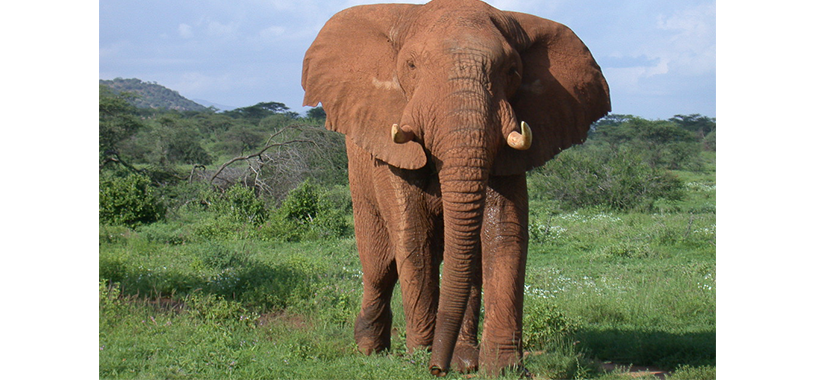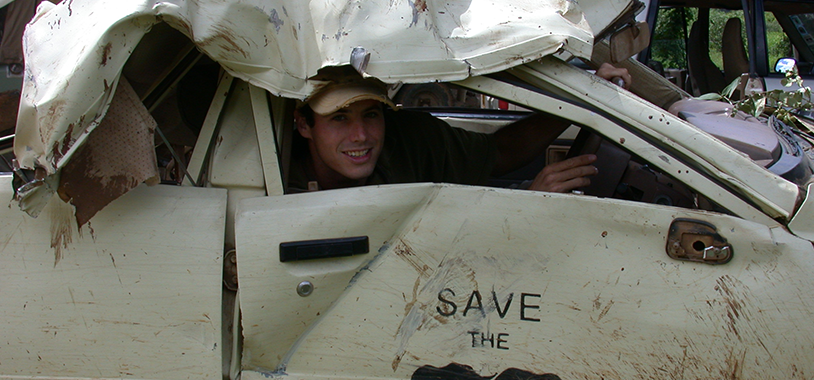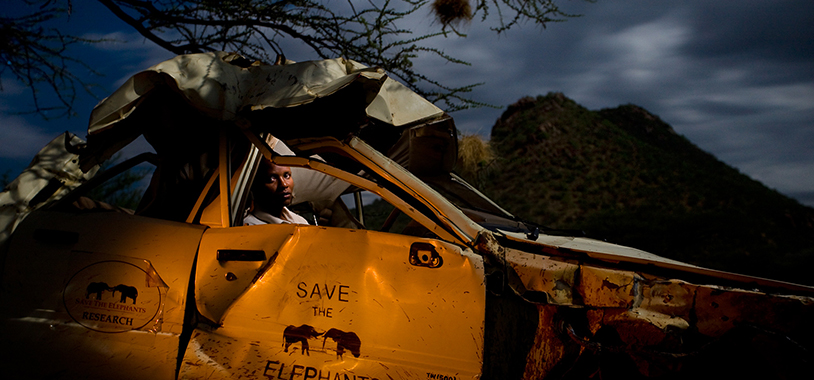There’s an African proverb that goes…’ when elephants fight, it is the grass that suffers’. In May 2002, it was more than the grass that suffered after a bull named Rommel redirected his aggression towards one of our research vehicles in Samburu National Reserve. Luckily, the two researchers in the vehicle – STE’s Scientific Board Chair, George Wittemyer, and his then research assistant, Daniel Lentipo – escaped unhurt. The Toyota, however, was completely rearranged by a raging Rommel. And now, 19 years later, the vehicle is on its way to Berlin for an exhibition at the Humboldt Forum on ivory. Read George’s first-hand account of the incident below and scroll down to watch a short video about the car leaving Samburu for its long-distance voyage.
Injured Bull Elephant in Musth Attacks My Vehicle By George Wittemyer (June 2002)
On May 19, 2002 in Samburu National Reserve in Kenya, Daniel Lentipo, my research assistant, and I were looking for a musth bull called Abraham Lincoln, known as Abe for short, who had been guarding an estrous female the day before.
We found him on a plain sparsely covered with small Acacia tortilis trees, in the middle of a fight with another large musth bull that had only recently arrived in the reserve. Though we have known Abe since the project began in 1997 the new bull had only been identified two weeks earlier. We drove up within 100 meters of the fighting bulls and stopped under a small Acacia tortilis tree to observe the fight. Abe’s right tusk was covered in blood, but he did not appear hurt. We assumed he must have tusked the newcomer. Because the newcomer’s back was towards us, we could not assess his condition.
Abe was facing us and slowly pushing the new bull in our direction. Both bulls were toying with the vegetation at their feet, but the new bull was gradually backing away from Abe. As if to demonstrate he was not yet finished, the newcomer began destroying a tree lying between the two bulls. After finishing the tree, he began turning towards us then back to Abe, slowly side stepping towards us. When he turned fully to face the car we could see where Abe’s tusk had penetrated between his left tusk and trunk. His left eye was slightly swollen and bright red, as if blood vessels had been burst from the impact of a hit.
He shook his head and stepped side to side in typical musth bull fashion, continually smelling his open wound and throwing dust and plants into the air. Injured, losing his fight with Abe, and smelling his own blood the new bull was sizing us up. It was a situation I had not seen before, but our usual rule is to sit quietly when elephants are near so as to avoid disturbing or exciting them. He approached the left front side of the car, with his full attention now locked on us. He thrust forward his ears, shook his head and side stepped throwing dust and debris into the air.
It seemed he would walk around the car, using us as a shield against Abe. I did not want to start the vehicle in case it spooked him. So we remained silent as he continued his threat display. As he reached the rear of the car and continued his threat displays, I realized he was facing our most vulnerable area, but I still did not imagine he would use force. Only when he stopped at the right rear side of the car did I have a sudden foreboding that he intended to destroy us.After seeing that we were shorter than he and had not responded to his display, perhaps he decided we were weaker than him.
He slightly cocked his head backwards and then ripped through the glass of the fiberglass cover on the back of my truck. As his head entered the car, I started the engine and tried to drive away. Unfortunately, he was thrashing his head up and down causing the car to jump violently sideways. I was knocked off the pedals of the car, and the car stalled. Though my memory of the following events is patchy, Daniel and I have tried to reconstruct what occurred by looking at the vehicle and putting together our minds to remember what unfolded. My truck hit the side of the acacia tree we were parked next to and he began to beat on us incessantly. I began to count his hits, thinking after 2 or 3 he would leave us. When I reached four I realized he had gone berserk.
He ripped off the fiberglass cover while pummeling the car from the right rear. He put his five tons behind each hit and then mashed his head around to rip apart the car. Moving to the back of the car, he hit us with such force that he snapped off the steel bumper and broke the chassis to which it was attached. He lifted the car from the rear and flipped it over on its side. Again he hit turning the car completely upside down. He backed off at this point. Daniel recalls I said he was leaving and we were going to be ok. I thought, momentarily, we were safe with the entire car and chassis above us. I tried to call the other researchers to warn them about the danger of this bull, but the radio was dead.
We had, 30 seconds of calm. Then he hit us so hard that the car was lifted into the air and flipped once again up onto its wheels. The force of that blow was tremendous – beyond anything I could fathom an animal capable of. I could see him clearly at this point, coming for my door. I felt he would not quit until he had finished us. Having totally demolished the rear end of the vehicle, it appeared that he was about to unleash his fury on the front. He drove his right tusk into the engine in front of me, the left tusk bounced off the cab carriage and scraped a deep dent in my door. At this moment Abe stepped forward. Perhaps Abe saw an opportunity to deal his rival a serious blow while he was preoccupied with us. In any event our huge aggressor withdrew and stood just next to my door, looking from me to Abe and back as if trying to decide on whom to focus.
Slowly he backed away, turning back and forth, until, when he was about 15 meters from the car, he locked his attention onto Abe. Daniel and I scrambled out through the battered remains of Daniel’s window. Keeping low to the ground, using the car as a shield against the attention of the bulls, we sprinted for safety, which turned out to be a grove of tall tortilis trees lying about 300 meters away. Halfway to the trees we checked behind us, but luckily the two bulls were again locked in their battle for dominance. The whole incident lasted approximately five minutes. Not a single window was left unshattered, none of the car body’s panels are salvageable, and the rear seat of the double cab truck is in tatters with one huge tusk hole penetrating through the seat and out the bottom of the car.
The roof of the cab, with a massive tusk hole and covered by blood smears from the bull, has been ripped from the rest of the body on three of its corners. From the wreckage we can see the tusk holes and dents from 5-6 massive blows. Incredibly Daniel and I were unhurt beyond a few slight scratches from the broken glass, but the force of those blows is something I will never forget nor know how to describe. The power of a raging bull is something more along the lines of a natural disaster than that of a living being. Some days later the bull was observed in the park amongst the great rainy season herds of Samburu. His only wounds were those dealt by Abe, as the annihilation of my truck did not cause him any damage. We have named the new bull Rommel, after the famous German tank commander of the Second World War, as this elephant easily ripped through a 4WD truck in the fashion of a tank. I have been following these elephants in Samburu studying their behaviour for the last five years and know every one of them.




